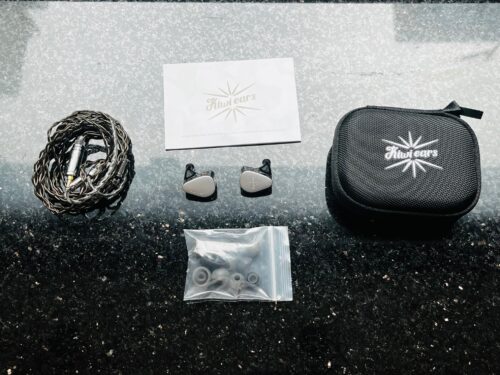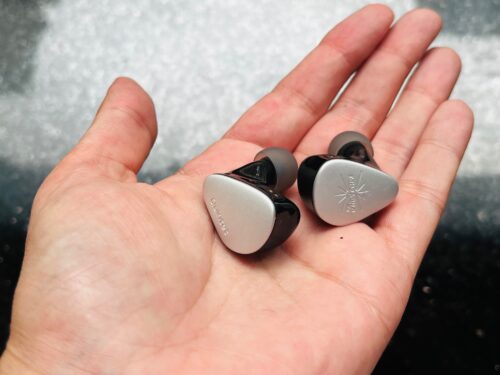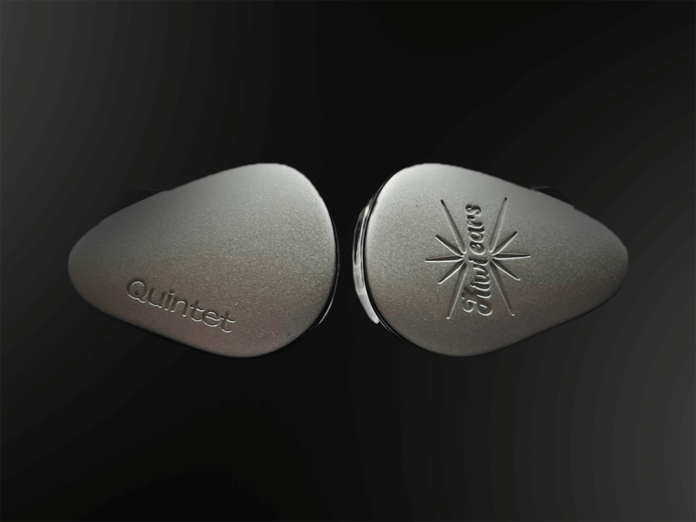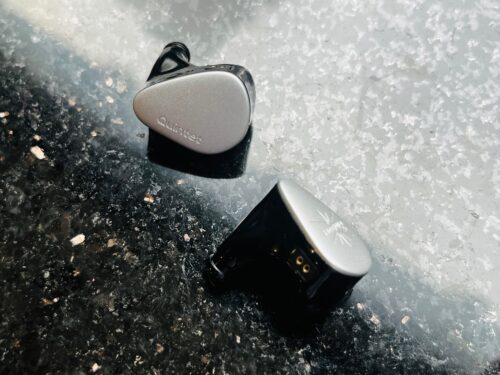Kiwi Ears are an unassuming little brand from Linsoul, often taking a back seat to the Company’s more famous, and generally more expensive brands, like Letshuoer and ThieAudio. But Kiwi Ears have always pleasantly surprised me, especially given the how budget friendly their models tend to be. So, I was curious to hear one of the brand’s most unique offerings, the Quintet. Packing 4 different driver types into its housing, how well does the Quintet perform? And does its ambitious design make for a distinctive sound signature?
What’s in the Box?
- Kiwi Ears Quintet
- Silver-plated copper cable
- 6 pairs of silicone ear-tips
- Carrying case

Look and Feel
The design of the Quintet’s shells resonates with a minimalist and sleek sensibility. The faceplates exhibit a subdued matte silver finish (with the brand logo), avoiding any glare and harmoniously contrasting the glossy, softly contoured black shells.
Despite their solid appearance, the shells are very lightweight, and in terms of comfort, the fit is reasonably accommodating. But, as expected, after wearing these IEMs for a couple of hours, I was inclined to take a break.

Design
The Kiwi Quintet showcases a blend of four driver types: a DLC dynamic driver, dual balanced armature drivers, a planar magnetic driver, and a piezoelectric bone conductor. The10mm DLC driver serves as the sub-woofer. The BA’s power the mids. And the MPT (Micro Planar Transducer) boasts distinct treble frequencies, diverging from the norm of BA or electrostatic tweeters found in most of today’s IEM models. In addition, a piezoelectric driver is implemented to emphasize ultra-treble details and an enhance the sense of spaciousness.
Although the Quintet is not too hard drive, it does seem to benefit from a little extra power. So, yes, you can plug these IEMs straight into your phone. But a DAP or portable DAC/amp will better help realize the potential of these IEMs and their unique driver setup.
Specifications
| Kiwi Ears Quintet | |
| Driver | 10mm DLC Dynamic + PZT + 2BA + 1 Planar Driver |
| Frequency Response | 20 – 30kHz |
| Impedance | 32 Ohms |
| Sensitivity | 106dB |
| Cable | 2-Pin |
Sound Impressions
Soundstage
The Quintet presents a grandness in scale that feels somewhat exaggerated. And I’m not complaining about it. Anthemic tracks, as well as those with intricate imaging arrangements feel huge, creating a serious wow factor, especially upon first listen. Most notable is the expansive width of the stage. And what is particularly entertaining about the stereo imaging is that even the most distant elements maintain the same color and definition as those that sit closer to the ear. So, although it may not be the most realistic stage, it’s damn fun, if not transcendental at times. The Quintet has also mastered the perception of depth. While most IEMs in this price range can achieve clear forward placement, it’s not often that you hear elements sitting genuinely behind the ear. In fact, there’s no angle that the Quintet fails to reach. And for sure, the Quintet’s broadly circular and nuanced soundscape is one of the standout features of its sound signature.
Low-End
The bass, though offering plenty power and warmth, feels a touch sluggish at times. But I’m also profoundly sleep deprived, so the slowed-down effect might have been partly psychological. Still, the Quintet does’t present a particularly tight low-end. But in terms of presence and depth, I certainly got the bass fix I needed; as the bass creeps down into the sub frequencies, the experience becomes strikingly visceral, reaching deep into the bones of the jawline, while also vibrating the throat. In fact, I had to take a break from heavy sub-bass tracks for a bit, because it felt akin to hearing/feeling your own heart beat. And as impressive and distinctive as this characteristic felt, the bodily effect was almost too much at times. In short, bass-heads will be thrilled.
Strings in this range also felt weighty and majestic. And although the timbre was darkly colored, the high level of texture and transparency was enough to bring a sense of realism to acoustic elements.
Mids
Although you will hear some low-mid presence, these frequencies do take a step back, allowing the upper half of the midrange to shine through the mix. But I wasn’t too hungry for more body, as the broad low-end provided enough warmth to complement the midrange tuning. Still, the recessed low-mids also allow for some tidy room between the heavy lows and higher frequencies. And certainly, there was no muddiness to speak of in the low mids.
The upper-midrange thins out a bit, lending a crispness and precision to the sound. Guitars, for example, are highly intricate, lean and edgy with a touch of shine. And this dramatic contrast in relation to the fat and juicy low-end, creates a nice balance in the overall weight of the sound signature.
Highs
It’s been a while since I’ve heard this much sparkle in the high-end. And listening to the intro of Daft Punk’s “Lose Yourself to Dance,” it felt like tiny diamonds were being tossed in the air. Percussion in this range has also has lean crispness, lending funk and energy to modern tracks. At times, I was hoping for little more character from vocal performances. There’s a little air here for sure, but note progressions didn’t feel distinctly playful or buoyant. That said, the Quintet showcase fantastic extension in this range. And resolution is top notch, revealing every breath and crackle in vocal deliveries. Surprisingly, I didn’t run into any fatigue either. Trumpets in the high-treble, for example, were never piercing or uncomfortable.
Final Verdict
The Quintet is certainly a unique and charismatic little IEM. Given that there are so many great models out on the market right now, it’s rare to find a sound signature this memorable, especially considering the price. In fact, the trippy soundstage alone is probably worth the 200 bucks. With a thunderous sub-bass, crisp, lean mids and uber-brilliant highs, the Quintet delivers a sound that’s as distinctive as the driver setup under the hood. Although it may not be the best choice for those in search of a “traditional” all-rounder, if you’re IEM collector, the Quintet will be a highly entertaining and one-of-a-kind addition to your arsenal.
The Kiwi Ears Quintet is coming soon to Audio 46.
Compare the ranking of various headphones, earbuds and in-ear monitors using our tools.
Discuss this, and much more, over on our forum.
---MAJORHIFI may receive commissions from retail offers.
















